The world is on the cusp of a new era in energy production, with nuclear energy playing a pivotal role in shaping the future. As global energy demands continue to rise, the importance of atomic energy as a clean and efficient source of power becomes increasingly evident.
Nuclear power is emerging as a vital component in the global energy mix, offering a reliable and sustainable alternative to fossil fuels. With its potential to significantly reduce greenhouse gas emissions, nuclear energy is poised to be a key player in the transition to a more sustainable energy future.
Key Takeaways
- The role of nuclear energy in meeting future energy demands.
- The benefits of nuclear power as a clean and efficient energy source.
- The potential of atomic energy to reduce greenhouse gas emissions.
- The significance of nuclear engineering in advancing energy technology.
- The future prospects of nuclear energy in the global energy landscape.
The Science Behind Nuclear Energy
At its core, nuclear energy production involves the manipulation of atomic structures to release energy. This process is grounded in the principles of nuclear physics, which studies the behavior of atomic nuclei.
Understanding Nuclear Fission and Fusion
Nuclear energy is primarily produced through two types of reactions: fission and fusion. Nuclear fission involves the splitting of heavy atomic nuclei into smaller nuclei, releasing a significant amount of energy in the process.
The Atomic Fundamentals
The atomic nucleus is composed of protons and neutrons, collectively known as nucleons. The stability of a nucleus depends on the balance between these nucleons.
Energy Release Mechanisms
The energy released during nuclear fission is due to the difference in binding energy between the original nucleus and the resulting nuclei. This energy is harnessed in nuclear reactors.
Basic Principles of Nuclear Physics
Nuclear physics is fundamental to understanding how nuclear energy is produced and controlled. Key concepts include radioactivity, half-life, and neutron interactions.
Radioactivity and Half-Life
Radioactivity is the process by which unstable nuclei lose energy through radiation. The half-life of a radioactive substance is the time required for half of the nuclei to decay.
Neutron Interactions
Neutrons play a crucial role in nuclear reactions. They can cause fission, be absorbed, or be scattered by nuclei, influencing the operation of nuclear reactors.
The understanding of these principles is essential for the safe and efficient operation of nuclear power plants. By grasping the science behind nuclear energy, we can better appreciate its potential as a clean and reliable source of power.
Historical Evolution of Nuclear Engineering
Nuclear engineering’s history is rooted in early atomic research, evolving significantly over the years. The journey from basic scientific discovery to practical application has been marked by significant milestones.
From Discovery to Application
The early 20th century saw the discovery of nuclear fission, a pivotal moment in nuclear physics. This led to the initiation of extensive research programs.
Early Atomic Research
Scientists like Enrico Fermi conducted crucial experiments, laying the groundwork for nuclear reactors.
Manhattan Project and Beyond
The Manhattan Project was a significant turning point, demonstrating the power of nuclear energy. Post-project, research continued, expanding the applications of nuclear technology.
Key Milestones in Nuclear Technology Development
The development of nuclear power plants marked a significant shift towards practical energy production.
First Nuclear Power Plants
The first commercial nuclear power plant, Calder Hall, was opened in 1956, paving the way for global nuclear energy adoption.
Evolution of Safety Standards
As nuclear technology advanced, so did safety protocols. Regulatory bodies were established to oversee the implementation of safety standards.
| Year | Event | Significance |
|---|---|---|
| 1934 | Enrico Fermi’s nuclear fission experiment | Demonstrated the feasibility of nuclear chain reactions |
| 1942 | Manhattan Project initiation | Developed atomic bombs, showcasing nuclear energy’s power |
| 1956 | Opening of Calder Hall | First commercial nuclear power plant, marking the beginning of nuclear energy for electricity generation |

The historical evolution of nuclear engineering is a testament to human ingenuity and the quest for sustainable energy solutions.
Types of Nuclear Reactors
Understanding the different types of nuclear reactors is essential for appreciating the complexity and versatility of nuclear energy. Nuclear reactors are categorized based on their design, functionality, and the coolant used.
Pressurized Water Reactors (PWRs)
Pressurized Water Reactors are the most common type of nuclear reactor. They use enriched uranium as fuel and water as both the coolant and moderator.
Design Characteristics
The design of PWRs involves a primary coolant loop that keeps the water under pressure to prevent boiling.
- The reactor core is submerged in a steel pressure vessel.
- A steam generator is used to produce steam that drives the turbines.
Operational Advantages
PWRs are known for their reliability and efficiency. They have a well-established operational history and are widely used in many nuclear power plants.
Key benefits include:
- High operational stability.
- Proven technology with extensive operational experience.
Boiling Water Reactors (BWRs)
Boiling Water Reactors produce steam directly, which then drives the turbines to generate electricity.
Functional Differences
Unlike PWRs, BWRs allow the water to boil, producing steam that directly drives the turbine.
This design simplifies the system by eliminating the need for a separate steam generator.
Efficiency Considerations
BWRs are designed to operate at a lower pressure than PWRs, which can affect their efficiency and power output.
- Simplified design with fewer components.
- Potential for lower construction costs.
Advanced Reactor Designs
Advanced reactor designs, including Generation IV concepts, focus on improved safety, efficiency, and sustainability.
Generation IV Concepts
Generation IV reactors represent the next generation of nuclear technology, with designs that offer enhanced safety features and better performance.
These reactors incorporate passive safety systems that do not require an external power source to cool the reactor in case of an emergency.
Advantages include:
- Enhanced safety through passive cooling systems.
- Potential for reduced construction and operational costs.
Nuclear Fuel Cycle
Understanding the nuclear fuel cycle is crucial for appreciating the intricacies of nuclear energy production. The nuclear fuel cycle encompasses a series of interconnected steps that are vital for the safe and efficient production of nuclear energy.
Mining and Processing Uranium
Uranium mining is the first step in the nuclear fuel cycle. Uranium is extracted from the earth through various methods.
Extraction Methods
There are several extraction methods used in uranium mining, including open-pit mining, underground mining, and in-situ leaching. Each method has its advantages and challenges, depending on the geology of the uranium deposit.
Environmental Considerations
Uranium mining can have environmental impacts, including the potential for water contamination and habitat disruption. Effective environmental management practices are essential to mitigate these risks.
Enrichment and Fuel Fabrication
After mining and processing, uranium undergoes enrichment to increase its concentration of U-235, the isotope used in most nuclear reactors.
Centrifuge Technology
Centrifuge technology is a common method used for uranium enrichment. It involves spinning uranium hexafluoride gas at high speeds to separate the isotopes based on their mass.
Fuel Assembly Design
Once enriched, the uranium is fabricated into fuel assemblies, which are carefully designed to optimize energy production and ensure safe operation within the reactor.
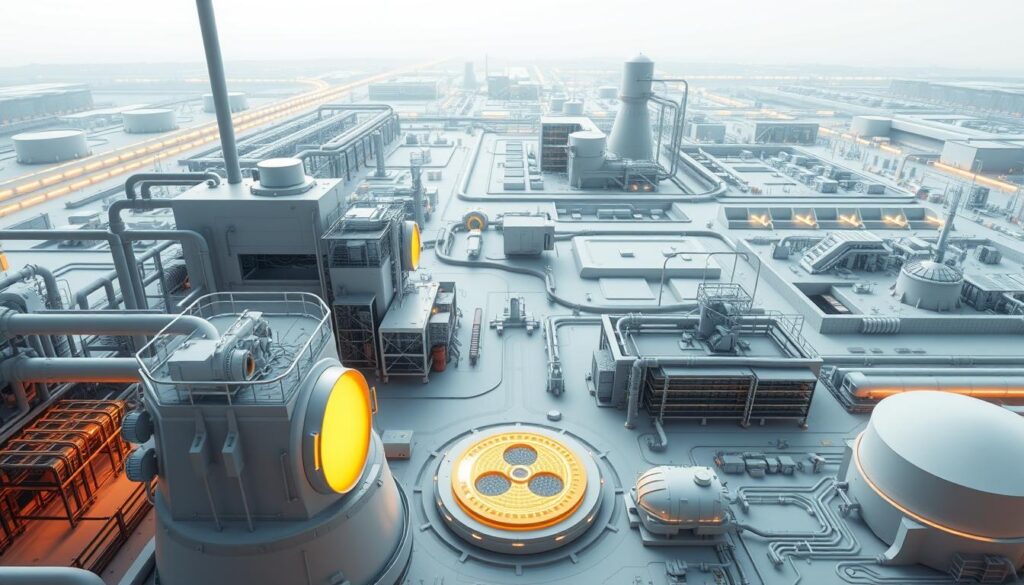
Spent Fuel Management
After use in a reactor, the spent fuel requires careful management due to its radioactive nature.
Interim Storage Solutions
Interim storage facilities provide a temporary solution for storing spent fuel, allowing it to cool down before further processing or disposal.
Reprocessing Options
Reprocessing spent fuel is an option that allows for the recovery of usable materials, reducing the volume of waste. However, it involves complex processes and raises proliferation concerns.
Nuclear Engineering: Core Disciplines and Specializations
Nuclear engineering’s complexity is reflected in its diverse range of core disciplines and specializations. This multifaceted field is crucial for advancing nuclear technology and ensuring the safe operation of nuclear facilities.
Reactor Design and Operation
Reactor design and operation are fundamental to nuclear engineering. This involves core physics modeling to understand the behavior of the reactor core, including neutron flux and power distribution.
Core Physics Modeling
Core physics modeling is essential for predicting reactor performance and safety. It involves complex simulations to model neutron behavior and interactions within the reactor core.
Control Systems Engineering
Control systems engineering is critical for maintaining reactor stability and responding to operational changes. Advanced control systems ensure the reactor operates within safe parameters.
Nuclear Materials Science
Nuclear materials science focuses on the development and characterization of materials used in nuclear reactors. Understanding radiation effects on materials is crucial for ensuring reactor longevity and safety.
Radiation Effects on Materials
Radiation can significantly impact material properties, leading to degradation over time. Research in this area helps develop materials that can withstand harsh reactor conditions.
Advanced Cladding Development
Advanced cladding materials are being developed to improve fuel efficiency and safety. These materials must withstand high temperatures and radiation exposure.
Thermal Hydraulics
Thermal hydraulics is vital for understanding heat transfer and fluid flow within nuclear reactors. This includes analyzing heat transfer mechanisms and coolant flow dynamics.
Heat Transfer Mechanisms
Heat transfer mechanisms are critical for removing heat from the reactor core. Understanding these mechanisms helps in designing more efficient cooling systems.
Coolant Flow Dynamics
Coolant flow dynamics play a crucial role in reactor safety and performance. Optimizing coolant flow helps prevent overheating and ensures stable operation.
The core disciplines and specializations within nuclear engineering are interconnected, each playing a vital role in the development of safe and efficient nuclear technology.
Nuclear Safety Systems and Protocols
Nuclear safety is achieved through a defense-in-depth strategy, incorporating multiple barriers and redundant systems to protect both the public and the environment.
Defense-in-Depth Approach
The defense-in-depth approach is fundamental to nuclear safety, ensuring that multiple layers of protection are in place to prevent accidents.
Multiple Barrier Concept
The multiple barrier concept involves several physical barriers between the radioactive materials and the environment, including fuel cladding, reactor coolant system, and containment structures.
Redundant Safety Systems
Redundant safety systems are designed to ensure that if one system fails, others can take its place, thereby maintaining the overall safety of the nuclear facility.
Regulatory Frameworks in the United States
The United States has a robust regulatory framework governing nuclear safety, led by the Nuclear Regulatory Commission (NRC).
Nuclear Regulatory Commission (NRC) Role
The NRC is responsible for licensing nuclear facilities, monitoring their operation, and enforcing compliance with safety regulations.
Licensing and Compliance
Nuclear facilities must obtain licenses from the NRC and comply with stringent safety standards to operate legally and safely.
Lessons from Historical Incidents
Historical incidents like Three Mile Island and Fukushima have provided critical lessons for improving nuclear safety.
Three Mile Island Analysis
The Three Mile Island accident highlighted the importance of operator training and the need for robust safety procedures.
Fukushima Safety Improvements
The Fukushima Daiichi disaster underscored the need for enhanced safety measures, including better flood protection and more stringent emergency preparedness.
As noted by the NRC, “The defense-in-depth philosophy is implemented through a combination of equipment and features, some of which are designed to prevent accidents, while others are designed to mitigate the consequences of accidents.”
This approach has been instrumental in maintaining the safety of nuclear facilities.
| Safety Measure | Description | Benefit |
|---|---|---|
| Multiple Barrier Concept | Physical barriers between radioactive materials and the environment | Prevents radioactive release |
| Redundant Safety Systems | Duplicate systems to ensure continued safety in case of failure | Enhances overall safety |
| NRC Oversight | Regulatory supervision by the NRC | Ensures compliance with safety standards |
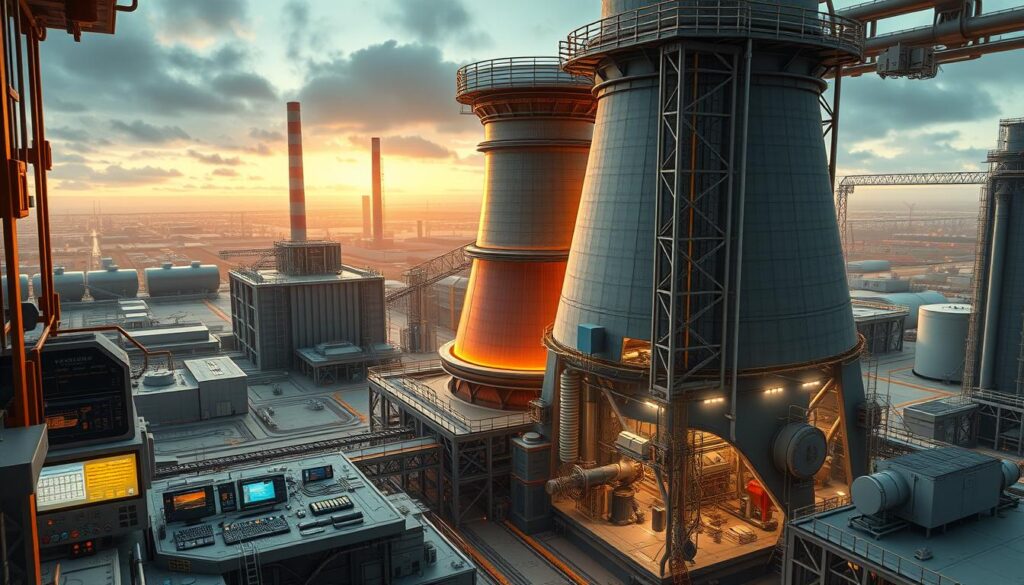
Radiation Protection and Health Physics
Effective radiation protection measures are essential for minimizing exposure and safeguarding health in environments where radiation is present. This critical aspect of nuclear engineering involves a comprehensive approach to ensure the safety of both workers and the general public.
Principles of Radiation Safety
The foundation of radiation safety lies in understanding and applying key principles that minimize exposure. These principles are based on the concepts of time, distance, and shielding.
Time, Distance, and Shielding
Reducing the time spent near a radiation source, increasing the distance from it, and using appropriate shielding are fundamental strategies for limiting exposure. By optimizing these factors, the dose of radiation received can be significantly reduced.
Dose Limits and ALARA Principle
Regulatory frameworks establish dose limits to protect individuals from the harmful effects of radiation. The ALARA principle (As Low As Reasonably Achievable) further emphasizes the need to minimize exposure to the lowest level possible, considering economic and societal factors.
Monitoring and Measurement Techniques
Accurate monitoring and measurement of radiation are crucial for effective radiation protection. This involves various techniques and tools to assess exposure levels.
Personal Dosimetry
Personal dosimetry involves the use of devices such as badges or rings to measure the radiation dose received by individuals. This information is vital for ensuring that exposure limits are not exceeded.
Environmental Radiation Detection
Environmental radiation detection systems are designed to monitor radiation levels in the surroundings, providing early warning systems in case of any anomalies. This is critical for both workplace safety and environmental protection.
| Technique | Description | Application |
|---|---|---|
| Personal Dosimetry | Measures radiation dose received by individuals | Workplace safety, health monitoring |
| Environmental Radiation Detection | Monitors radiation levels in the environment | Environmental protection, emergency response |
| Shielding | Uses materials to block or reduce radiation | Radiation facilities, medical applications |
Environmental Impact of Nuclear Power
Understanding the environmental implications of nuclear power is crucial for evaluating its role in the future energy mix. Nuclear power plants generate electricity without emitting greenhouse gases during operation, making them an attractive option for reducing carbon emissions.
Carbon Footprint Comparison
The carbon footprint of nuclear power is significantly lower than that of fossil fuels when considering the entire lifecycle emissions.
Lifecycle Emissions Analysis
Studies have shown that nuclear power plants produce approximately 2-4 grams of CO2 equivalent per kilowatt-hour (g CO2-eq/kWh) of electricity generated, compared to 400-1000 g CO2-eq/kWh for fossil fuel-based power plants.
Land Use Efficiency
Nuclear power plants require relatively small land areas compared to renewable energy sources like solar or wind farms, making them a more land-efficient option.
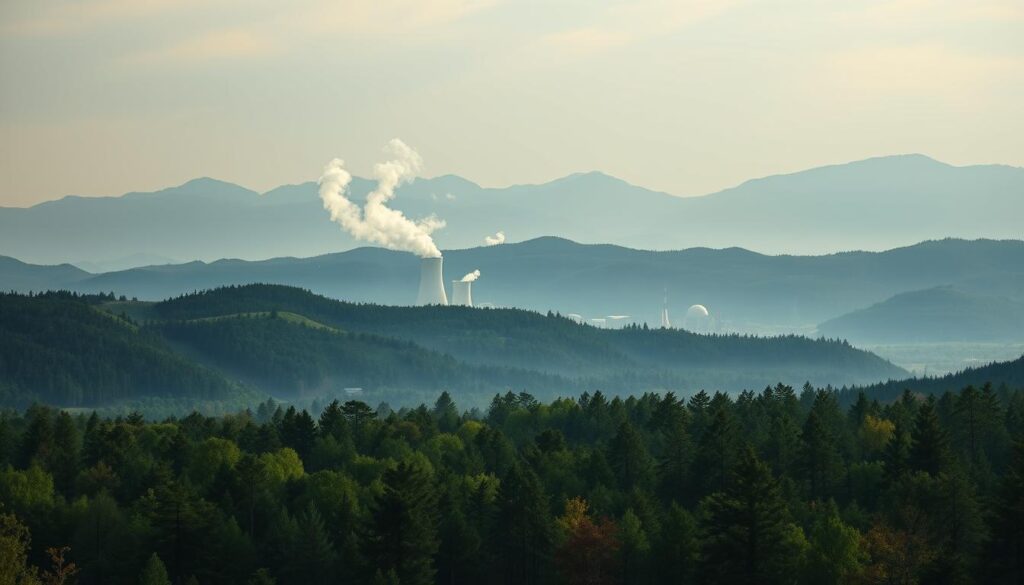
Waste Management Challenges and Solutions
One of the significant environmental challenges associated with nuclear power is the management of nuclear waste.
High-Level Waste Disposal
High-level waste, which includes spent nuclear fuel, requires specialized storage and disposal facilities to prevent environmental contamination.
Deep Geological Repositories
Deep geological repositories are considered a promising solution for the long-term storage of high-level nuclear waste, providing a secure and isolated environment.
Nuclear power offers a low-carbon alternative to fossil fuels, but it comes with its own set of environmental challenges, particularly regarding waste management. By understanding these impacts and developing effective solutions, we can better assess the role of nuclear power in a sustainable energy future.
Nuclear Engineering Education and Training
As the demand for clean energy grows, nuclear engineering education and training become increasingly important. The field requires a comprehensive approach to educating future engineers, focusing on both theoretical knowledge and practical skills.
Undergraduate and Graduate Programs
Nuclear engineering programs are offered at various universities across the United States. These programs range from undergraduate to graduate levels, providing a thorough understanding of nuclear principles, reactor design, and nuclear safety.
Core Curriculum Components
The core curriculum for nuclear engineering typically includes:
- Nuclear physics and reactor theory
- Thermal hydraulics and fluid mechanics
- Nuclear materials science
- Radiation protection and health physics
Top U.S. Nuclear Engineering Schools
Some of the top nuclear engineering schools in the U.S. include:
| Rank | University | Program Highlights |
|---|---|---|
| 1 | Massachusetts Institute of Technology (MIT) | Advanced reactor design, nuclear security |
| 2 | University of Michigan | Nuclear energy systems, radiation detection |
| 3 | University of California, Berkeley | Nuclear physics, energy policy |
Specialized Certifications and Continuing Education
Beyond traditional degree programs, specialized certifications and continuing education are crucial for nuclear engineers. These programs help professionals stay updated with the latest technologies and regulatory requirements.
Professional Engineering Licensure
Obtaining a Professional Engineer (PE) license is a significant step in a nuclear engineer’s career. It demonstrates expertise and commitment to the field.
Industry-Specific Training
Industry-specific training programs are available for nuclear engineers to gain hands-on experience with specific reactor designs, safety protocols, and operational procedures.
Career Opportunities in Nuclear Engineering
The field of nuclear engineering is rich with diverse career paths, from power generation to research and development. Professionals in this field contribute to the safe and efficient production of energy, advancement of nuclear technology, and development of safety protocols.
Roles in Power Generation
Nuclear power generation is a significant sector within nuclear engineering, offering various career opportunities.
Plant Operations and Management
Plant operations and management involve overseeing the day-to-day activities of nuclear power plants, ensuring they operate safely and efficiently.
Design and Construction
Design and construction roles focus on the development and implementation of new nuclear reactor designs and the construction of nuclear facilities.
Research and Development Positions
Research and development in nuclear engineering drive innovation and improvement in nuclear technology.
National Laboratory Opportunities
National laboratories offer research opportunities focused on advancing nuclear science and technology, including projects on reactor design and nuclear materials.
Private Sector Innovation
The private sector is also a significant player in nuclear research and development, with companies investing in new technologies and reactor designs.
Regulatory and Safety Careers
Regulatory and safety careers are crucial for ensuring that nuclear facilities operate within strict safety guidelines.
Inspection and Compliance
Inspection and compliance roles involve monitoring nuclear facilities to ensure they adhere to regulatory standards.
Policy Development
Policy development is essential for creating and updating regulations that govern the nuclear industry, ensuring safety and efficiency.
Here’s a summary of the career paths and their primary focuses:
| Career Path | Primary Focus |
|---|---|
| Plant Operations and Management | Safety and Efficiency |
| Design and Construction | Innovation and Implementation |
| Research and Development | Advancement of Technology |
| Regulatory and Safety | Compliance and Policy |
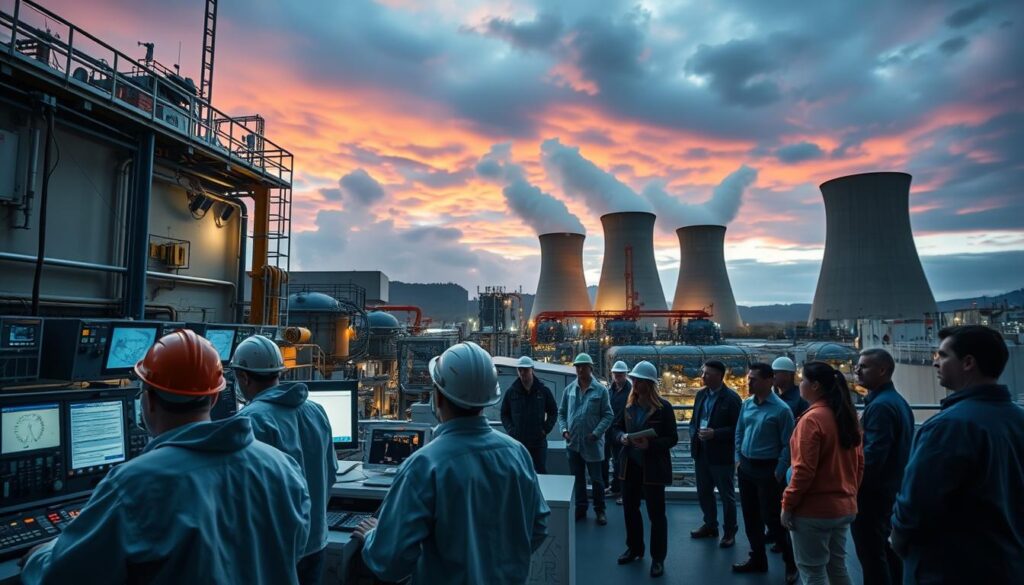
Nuclear Engineering in Medicine and Healthcare
The application of nuclear engineering principles has revolutionized medical practices, enhancing both diagnostic capabilities and therapeutic interventions. Nuclear medicine, a field that combines nuclear engineering and medical science, has become indispensable in healthcare.
Diagnostic Imaging Technologies
Nuclear engineering has significantly advanced diagnostic imaging technologies, enabling healthcare professionals to visualize the body’s internal structures with unprecedented clarity. Techniques such as PET (Positron Emission Tomography) and SPECT (Single Photon Emission Computed Tomography) scanning have become crucial in diagnosing and managing various diseases.
PET and SPECT Scanning
PET and SPECT scanning utilize radiopharmaceuticals to provide detailed images of the body’s metabolic activities. These imaging modalities are vital in oncology, cardiology, and neurology, allowing for early detection and treatment of diseases.
Radiopharmaceutical Development
The development of radiopharmaceuticals is a critical aspect of nuclear medicine. These compounds are designed to target specific areas or processes within the body, providing valuable diagnostic information and, in some cases, delivering therapeutic doses of radiation directly to diseased tissues.
Radiation Therapy Advancements
Nuclear engineering has also driven advancements in radiation therapy, a cornerstone of cancer treatment. Techniques such as intensity-modulated radiation therapy (IMRT) and proton therapy have improved treatment outcomes by allowing for more precise targeting of tumors.
Targeted Cancer Treatments
Targeted cancer treatments, facilitated by advancements in nuclear engineering, have enhanced the efficacy of radiation therapy while minimizing damage to surrounding healthy tissues. This precision is crucial in improving patient outcomes and reducing side effects.
Medical Isotope Production
Medical isotopes are essential for both diagnostic and therapeutic applications. Nuclear reactors and accelerators produce these isotopes, which are then used in various medical procedures, including cancer treatment and imaging studies.
| Application | Description | Benefit |
|---|---|---|
| PET Scanning | Uses radiopharmaceuticals to visualize metabolic activity | Early detection of diseases |
| SPECT Scanning | Provides detailed images of internal structures | Accurate diagnosis and disease management |
| Radiation Therapy | Delivers precise doses of radiation to tumors | Effective cancer treatment with minimal side effects |
As noted by Dr. Edward Hoffman, a pioneer in nuclear medicine, “The future of nuclear medicine lies in its ability to integrate with other medical disciplines, providing comprehensive care through advanced diagnostic and therapeutic technologies.”
“Nuclear medicine has transformed the way we diagnose and treat diseases, offering unparalleled insights into the human body.”
Nuclear Technology in Space Exploration
Space exploration is on the cusp of a new era, thanks to advancements in nuclear technology. As missions become more ambitious and distant, the need for reliable and long-lasting power sources has never been more critical.
Radioisotope Power Systems
Radioisotope Power Systems (RPS) have been a cornerstone of space exploration, providing electricity for numerous missions. These systems convert the heat generated by radioactive decay into electrical energy.
Mars Rover Applications
The Mars rovers, such as Curiosity, have utilized RPS to power their systems, enabling prolonged exploration of the Martian surface.
Deep Space Mission Requirements
For deep space missions, RPS offers a reliable source of power where solar panels are ineffective due to the vast distances from the Sun.
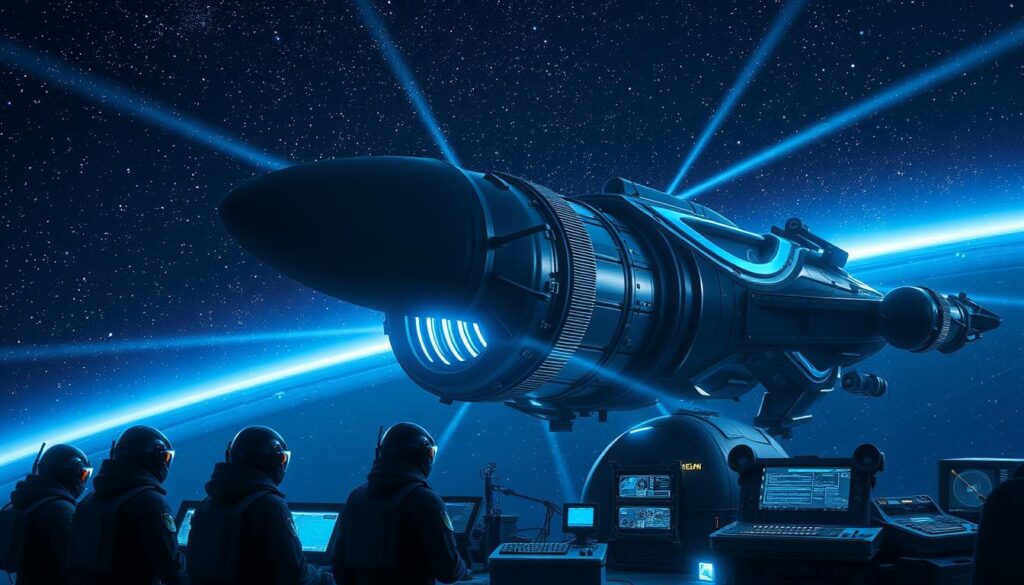
Nuclear Propulsion Concepts
Nuclear propulsion is being explored for its potential to significantly enhance the efficiency of space travel. This technology could reduce travel times to distant planets.
Nuclear Thermal Rockets
Nuclear Thermal Rockets (NTRs) use nuclear reactors to heat propellant, generating thrust. NTRs promise higher efficiency compared to traditional chemical propulsion.
NASA’s Current Research Initiatives
NASA is actively researching nuclear propulsion concepts, including NTRs, to support future manned missions to Mars and beyond.
Key benefits of nuclear technology in space include:
- Long-lasting power sources
- Enhanced mission duration and range
- Potential for faster travel times with nuclear propulsion
Innovations in Nuclear Fusion Research
The future of energy is being shaped by innovations in nuclear fusion, including advancements in tokamak design and private sector investments. Nuclear fusion, the process that powers the sun, has long been considered a holy grail for clean energy. Recent breakthroughs are bringing this vision closer to reality.
ITER and International Collaboration
The International Thermonuclear Experimental Reactor (ITER) is a landmark project in nuclear fusion research, representing a significant international collaboration. ITER aims to demonstrate the feasibility of fusion power by achieving a controlled, sustained fusion reaction.
Tokamak Design Principles
The tokamak design is central to ITER’s approach, using a toroidal (doughnut-shaped) chamber to confine the hot plasma in which fusion occurs. This design relies on powerful magnetic fields to contain and stabilize the plasma.
Expected Milestones
ITER is expected to achieve first plasma in the late 2020s, with full-power deuterium-tritium operation planned for the early 2030s. These milestones will be crucial in demonstrating the viability of fusion power.
Private Sector Fusion Initiatives
In addition to ITER, private companies are making significant strides in nuclear fusion. Commonwealth Fusion Systems and TAE Technologies are among the leaders in this space, developing innovative approaches to fusion energy.
Commonwealth Fusion Systems
Commonwealth Fusion Systems is working on a compact fusion device, leveraging advancements in superconducting magnets to achieve a stable, high-field tokamak design.
TAE Technologies Approach
TAE Technologies is pursuing a different approach, using a field-reversed configuration to achieve fusion. Their method involves creating a high-energy plasma state that can be sustained for longer periods.
Potential Timeline for Commercial Fusion
The timeline for commercial fusion energy is ambitious, with several technical hurdles remaining. However, projections suggest that fusion could become a significant energy source by the mid-21st century.
Technical Hurdles Remaining
Key challenges include achieving sustained plasma confinement, developing materials that can withstand the extreme conditions inside a fusion reactor, and demonstrating economic viability.
Economic Viability Projections
Early estimates suggest that fusion energy could be competitive with other forms of energy production, especially as the technology advances and economies of scale are realized.
| Initiative | Approach | Expected Timeline |
|---|---|---|
| ITER | Tokamak Design | First plasma late 2020s |
| Commonwealth Fusion Systems | Compact Fusion Device | Early commercialization in the 2030s |
| TAE Technologies | Field-Reversed Configuration | Commercialization in the 2030s-2040s |
Small Modular Reactors: The Next Generation
Small Modular Reactors (SMRs) represent a significant shift in nuclear energy production, offering enhanced scalability and flexibility. These reactors are designed to be smaller, more efficient, and cost-effective compared to traditional nuclear reactors.

Design Advantages and Applications
SMRs offer several design advantages, including:
- Scalability: SMRs can be scaled up or down depending on energy demands.
- Flexibility: They can be deployed in a variety of locations, including remote areas.
Scalability and Flexibility
The scalability of SMRs allows utilities to incrementally add capacity as needed, reducing the financial burden of large upfront investments. Their flexibility also makes them suitable for a wide range of applications, from powering small grids to providing energy for industrial processes.
Factory Fabrication Benefits
SMRs are fabricated in a factory setting, which enhances quality control and reduces construction time. This approach minimizes on-site labor and reduces the risk of construction delays.
Economic and Deployment Considerations
The economic viability of SMRs is a critical factor in their adoption. Companies like NuScale Power are at the forefront of developing these reactors.
NuScale Power’s Progress
NuScale Power has made significant progress in developing its SMR design, with several projects in various stages of deployment. Their design has received regulatory approval in the United States, paving the way for commercial deployment.
Regulatory Pathway in the U.S.
The regulatory pathway for SMRs in the U.S. is being streamlined to facilitate their deployment. The Nuclear Regulatory Commission (NRC) has established a framework for reviewing SMR designs, ensuring that they meet safety and security standards.
Nuclear Energy in the Clean Energy Transition
With its unique ability to provide baseload power without emitting greenhouse gases, nuclear energy is set to be a cornerstone of the clean energy transition.
Integration with Renewable Energy Systems
Nuclear energy can complement renewable energy sources by providing a stable and reliable source of power. This integration is crucial for achieving a balanced energy mix.
Load Following Capabilities
Modern nuclear reactors are designed with load following capabilities, allowing them to adjust their power output in response to changes in electricity demand.
Grid Stability Contributions
By providing a constant source of power, nuclear energy helps maintain grid stability, which is essential for the widespread adoption of intermittent renewable energy sources.
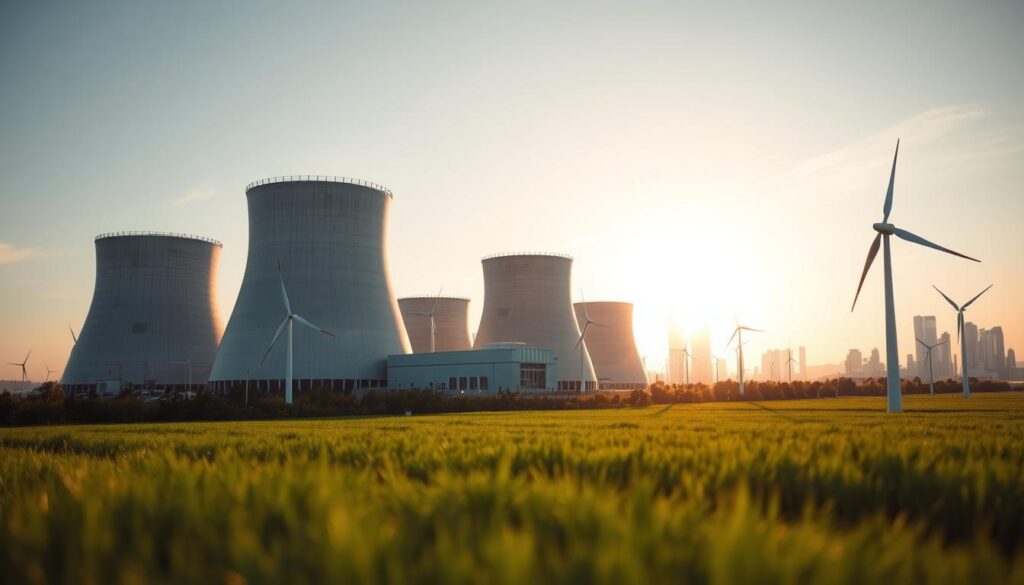
Role in Decarbonization Strategies
Nuclear energy plays a vital role in decarbonization strategies by offering a low-carbon alternative to fossil fuels.
Replacing Fossil Fuel Baseload
Nuclear power plants can replace fossil fuel baseload power, significantly reducing greenhouse gas emissions from the energy sector.
Hydrogen Production Potential
Nuclear energy can be used to produce hydrogen through electrolysis or thermochemical processes, providing a clean fuel for various applications.
The integration of nuclear energy into the clean energy transition is a strategic move towards achieving a low-carbon future. By leveraging its capabilities, we can ensure a reliable and sustainable energy supply.
- Nuclear energy provides baseload power without greenhouse gas emissions.
- It complements renewable energy sources by ensuring grid stability.
- Nuclear power can be used for hydrogen production, offering a clean fuel alternative.
Conclusion: The Enduring Promise of Nuclear Engineering
Nuclear engineering stands at the forefront of the global energy landscape, offering a cleaner, more sustainable alternative to traditional fossil fuels. As the world grapples with the challenges of climate change and energy security, the nuclear engineering future looks brighter than ever.
The promise of nuclear energy lies in its ability to provide baseload power with minimal environmental impact. With advancements in reactor design, safety protocols, and waste management, nuclear power is poised to play a vital role in the clean energy transition.
As highlighted throughout this article, nuclear engineering encompasses a broad range of disciplines, from reactor design and operation to radiation protection and nuclear materials science. The field’s complexity and nuance underscore its potential to drive innovation and meet growing global energy demands.
Embracing the nuclear energy promise means investing in a future where energy is not only sustainable but also reliable and efficient. As the world continues to evolve, nuclear engineering will remain a critical component of our collective efforts to mitigate climate change and ensure a prosperous future for generations to come.
